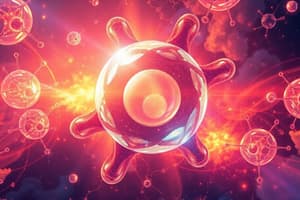Podcast
Questions and Answers
What makes up about 100 basic substances?
What makes up about 100 basic substances?
- Atoms (correct)
- Molecules
- Elements
- Compounds
What types of atoms are found in the Earth's crust and living things?
What types of atoms are found in the Earth's crust and living things?
- Hydrogen (correct)
- Carbon (correct)
- Noble Gases
- Oxygen (correct)
How are symbols of elements displayed?
How are symbols of elements displayed?
Two letters
What are the 4 basic parts of the structure of an atom?
What are the 4 basic parts of the structure of an atom?
What is a nucleus?
What is a nucleus?
What is an electron?
What is an electron?
Describe how small an atom is.
Describe how small an atom is.
What are the 3 types of particles in an atom?
What are the 3 types of particles in an atom?
Which particle is the smallest in an atom?
Which particle is the smallest in an atom?
What does an atomic number represent?
What does an atomic number represent?
Can an element have varied types?
Can an element have varied types?
What are isotopes?
What are isotopes?
How do atoms form ions?
How do atoms form ions?
What is an ion?
What is an ion?
Flashcards are hidden until you start studying
Study Notes
Basic Concepts of Atoms
- Atoms make up approximately 100 basic substances that constitute all matter we can see or touch.
- 90% of the mass of the universe is comprised of atoms found in the Earth's crust and living organisms.
Atomic Structure
- The structure of an atom consists of four basic parts, including the nucleus and electrons.
- The nucleus is the central part of the atom housing protons and neutrons.
Particles in an Atom
- Electrons are negatively charged particles located outside the nucleus.
- Atoms are extremely small; millions can fit on the head of a pin.
- There are three primary types of atomic particles: protons, electrons, and neutrons.
- Electrons are the smallest of these particles, significantly smaller than neutrons and protons.
Atomic Properties
- The atomic number represents the number of protons present in an atom's nucleus.
- Elements may have varied types called isotopes, which differ in the number of neutrons while having the same number of protons.
Isotopes and Ions
- Isotopes are variations of an atom that possess the same number of protons but different numbers of neutrons.
- Atoms can form ions by losing or gaining electrons, resulting in an unbalanced electric charge.
- An ion is defined as an atom or group of atoms that possesses a positive or negative electric charge.
Studying That Suits You
Use AI to generate personalized quizzes and flashcards to suit your learning preferences.



